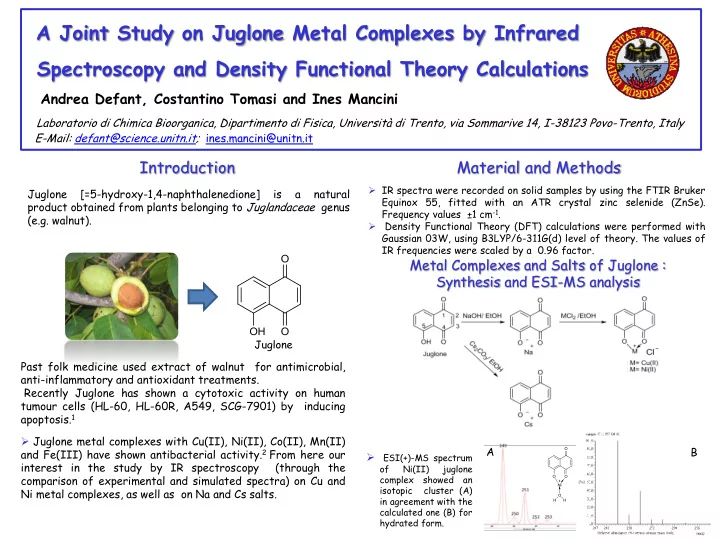

A Joint Study on Juglone Metal Complexes by Infrared Spectroscopy and Density Functional Theory Calculations Andrea Defant, Costantino Tomasi and Ines Mancini Laboratorio di Chimica Bioorganica, Dipartimento di Fisica, Università di Trento, via Sommarive 14, I-38123 Povo-Trento, Italy E-Mail: defant@science.unitn.it; ines.mancini@unitn.it Introduction Material and Methods IR spectra were recorded on solid samples by using the FTIR Bruker Juglone [=5-hydroxy-1,4-naphthalenedione] is a natural Equinox 55, fitted with an ATR crystal zinc selenide (ZnSe). product obtained from plants belonging to Juglandaceae genus Frequency values ±1 cm -1 . (e.g. walnut). Density Functional Theory (DFT) calculations were performed with Gaussian 03W, using B3LYP/6-311G(d) level of theory. The values of IR frequencies were scaled by a 0.96 factor. Metal Complexes and Salts of Juglone : Synthesis and ESI-MS analysis Past folk medicine used extract of walnut for antimicrobial, anti-inflammatory and antioxidant treatments. Recently Juglone has shown a cytotoxic activity on human tumour cells (HL-60, HL-60R, A549, SCG-7901) by inducing apoptosis. 1 Juglone metal complexes with Cu(II), Ni(II), Co(II), Mn(II) A B and Fe(III) have shown antibacterial activity. 2 From here our ESI(+)-MS spectrum interest in the study by IR spectroscopy (through the of Ni(II) juglone comparison of experimental and simulated spectra) on Cu and complex showed an isotopic cluster (A) Ni metal complexes, as well as on Na and Cs salts. in agreement with the calculated one (B) for hydrated form.
Results and Discussion Frequency assignments of the groups involved in each complex Over the last decades, infrared spectroscopy has formation and in alkali salts, reported in experimental IR experienced a renewed role in the molecular structure spectra, were obtained by DFT calculated spectra. elucidation of organic compounds, due to the availability of simulated spectra by density functional theory (DFT) calculations, used to assign the frequencies of chemical bonds through comparison with experimental data. 1 1 4 5 4 5 Frequency (cm -1 ) Frequency (cm -1 ) Absorbance Absorbance Wavenumber (cm -1 ) Wavenumber(cm -1 ) Figure 2. Region in IR spectra for juglone-Ni(II) complex: experimental Figure 1. Region in IR spectra for juglone: experimental (bottom) (bottom) and DFT calculated (top) with assignments according to the and DFT calculated (top) with assignments according to the numbering reported on the energy-minimized structure. numbering reported on the energy-minimized structure.
The most significant experimental and calculated values for the functional groups present on juglone structure involved in the complexation with alkali ions are reported in Table 1 . calculated frequencies for C(4)=O and C(5)-O - groups in the free juglone anion are equivalent due to: Table 2 ν (cm -1 ) ν (cm -1 ) ν (cm -1 ) Exp Calcd Exp Calcd Exp Calcd C(1)=O 1663 1667 1655 1676 1661 1676 computed data for the structure regarding the alkali metal C(4)=O 1638 1631 1391 1383 1383 1389 ion are in agreement with the experimental values. C(2)=C(3) 1592 1590 1619 1600 1591 1595 C(5 )−O 1288 1291 1424 1430 1441 1439 The C(4)=O and C(5)-O - groups in the salts are affected by the metal ion. Conclusions Although the comparison between experimental spectra Table 1 recorded in the solid state and DFT calculated frequencies ν (cm -1 ) ν (cm -1 ) ν (cm -1 ) in gas phase, the relatively simplified model here proposed Calcd Calcd Calcd provides a good agreement for the group frequencies in the Exp Calcd Exp Exp anion salt salt two systems. C(1)=O 1663 1667 1660 1628 1653 1578 1542 Significant variations were observed for the alkali salts with C(4)=O 1638 1631 1574 1615 1553 1452 1484 the only evidence for ion-dipole interactions, whereas the C(2)=C(3) 1592 1590 1628 1628 1617 1612 1617 changes in Cu (II) and Ni(II) complexes are attributable to C(5 )−O 1288 1291 1459 1615 1437 1417 1419 the involvement of chelation. References Table 2 reports data for Cu and Ni complexes. 1. Polonik S. G., Prokof’eva N. G., Agafonova I. G., Uvarova N. I., C(4)=O group actively participates to chelation, it shows a J. Pharm. Chem., 2003 , 37 , 397-398 greater decrease in frequency value, corresponding to the 2. Joshi C. R., Indian J. Pharm. Sci., 1986 , 48 , 101-104 partial loss of double bond character. C(5)-O group undergoes an increase of frequency value for resonance stabilization and chelation.
Recommend
More recommend